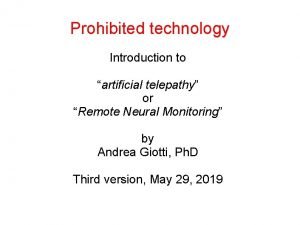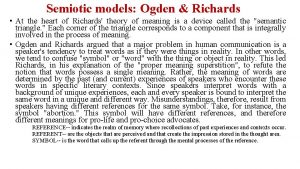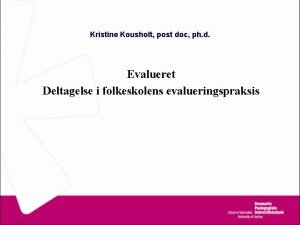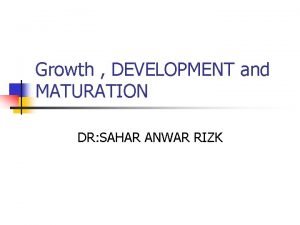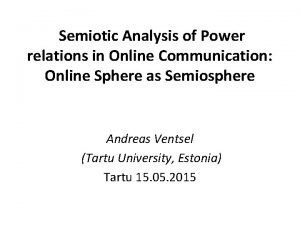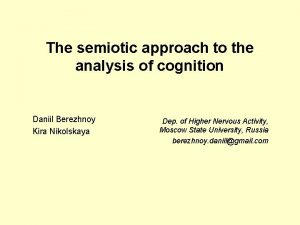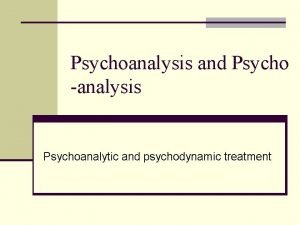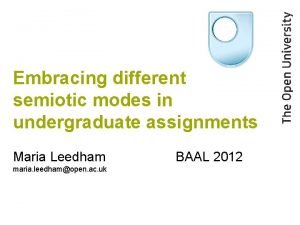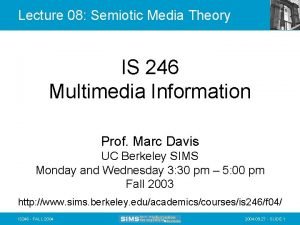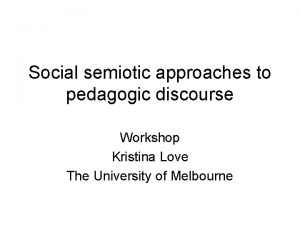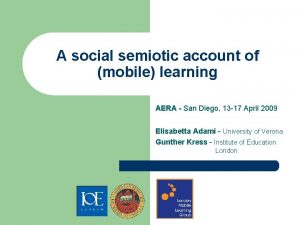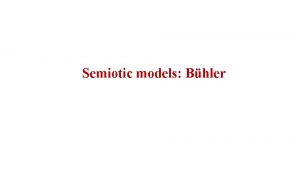Psycho Semiotic analysis of Sahar Khalifehs Muakira t




















- Slides: 20

Psycho -Semiotic analysis of Sahar Khalifeh’s Muðakira: t Imra'atin Gheiru Waqeai'atin Eman A. S Hijazi MA student Linguistics and translation the Islamic university Gaza Strip - Palestine

Abstract This study investigates how the Palestinian feminist novelist Sahar Khalifeh deploys the signs in her novel “Mu ðakirat Imra’atin Gheiu Waqeai’atin =The Memoirs of an Unrealistic Woman= ” ﻭﺍﻗﻌﻴ ﺇﻣﺮﺃﻏﻴ ﺫﻛﺮﺍﺕ to addresses the issue of a woman by applying a psycho-semiotic analysis on the Arabic discourse. The psycho-semiotic analysis sheds the light on how the protagonist of the novel deploys the signs in her feminist narrative discourse to introduce the tortured woman. The researchers use both qualitative and quantitative methods to highlight how the novelist deploys the signs depending on Charles Pierce’s model of semiotic analysis to indicate how the social and cultural conventions affect the life of the Palestinian woman’s life. Pierce divided the sign into three parts; icon, index, and symbol. Therefore, the researcher intends to analyze the words, sentences, and paragraphs, which indicated the symbols in the novel, taking into consideration the Arabic text the researcher. The results of the study indicate that Sahar Khalifeh uses many signs by deploying bringing her personality down on concrete things as a reference to the catastrophic situation that woman surrenders with because of old social values.

The Image of Woman in Sahar Khalifeh’ S Novels Sahar Khalifeh is considered as the first female novelist who demands the freedom of woman from the inherited social restrictions that contribute to reinforce injustice against women. Khalifeh focuses on several humanitarian issues related to woman and her core role in society. Her Novel, "Inheritance, " Al-Meerath has a significant role in presenting the Palestinian situation after the peace agreement, where she discussed the return of the displaced Palestinian and how they conveyed the culture of exile to both Gaza and the West Bank. "Inheritance" has a great impact on obtaining Sahar Khalifeh International fame since a number of her novels have been translated into several languages such as English, Dutch, and French. None of the novelists denies the woman's role in supporting her husband during his confrontation with the occupation where several images of women are presented: a daughter. a wife and a mother. Palestinian Literature tackles the issue of diaspora and displacement because of the Zionist occupation. The aesthetic description of woman's image of Khalifeh's literary works, particularly her feminist novels Lam Nao'd lakom Jawari(1974), Alhob Al. Awal(2010) ﺍﻷﻮﻝ ﺍﻟﺤﺐ , Mu ðakirat Imra'atin Gheiru Waqa'eatin (1986) ﻣﺬﻛﺮﺍﺕ ﺇﻣﺮﺃﺔ ﻏﻴﺮ ﻭﺍﻗﻌﻴﺔ and Rewaiati Le Rewa'iati (2018) ﺭﻭﺍﻳﺘﻲ ﻟﺮﻭﺍﻳﺘﻲ , she intends to present a perfect image of the oppressed woman. Khalifeh admits in her feminist and political novels that each woman can not exceed her duties toward the society; however, each one has her own different story, (Sadeq, 2013).

Al. Qasim (2005) stated that Khalifeh sheds light on the most two familiar narratives aspects in her novels; therefore, it became difficult to break through the struggle against the strange occupier and the struggle against the masculine society. She is suffering from what the Palestinian man is suffering under the occupation; hence, she considers the equality between males and females as a tool of resistance contributing to building up the Palestinian society. She depicts depicting the life of the oppressed Palestinian woman socially which she delineates a beautiful image of woman s' struggle with the old conventions recently, (Koy, Greg, & Denise Obitz-cooney, 2016). Khalifeh innovatively succeeds in providing the reader with a picture of the everyday life of the Palestinian society and its complexities without neglecting the issue of woman. In her novel, Sun Flowers (Aba'ad Alshams) (1980), Khalifeh portrays the life of a disappointed girl (Rafeef) who was shocked that her beloved (Adel oppressed her when he left her because she worked with the resistant. Moreover, she struggles with the old customs that prevent her from dealing with a journal. In, another novel the Cactus -Sabar( 1976), Khalifeh successfully combines love and resistance by introducing a fantastic image of a woman who sacrifices to keep on her love. Additionally, it tackles some social relations in the Palestinian society and its causes and effects on the Palestinians.

Why does the researcher choose the Selected Novel: Muðakirat Imra'atin Gheiru Waqeai'atin? Through delving into the selected Novel Mu ðakirat Imra'atin Gheiru Waqeai'atin, its obvious Khakifeh concentrates on criticizing the outdated social values that cause the catastrophic conditions that women are suffering from and believes that respecting a woman's rights is the first way to liberate the homeland “Palestine”. She highlights the role that a woman plays in supporting men socially, politically, and economically. Additionally, she describes the continuing injustice and painful life despite her sharing men in all aspects of life contrary to her other novels in which she strengthens the status of woman and her role in resisting the occupation beside her husband, brother, son, and parent. Regarding this point, the researcher intends to analyze the used language stylistically to represent the image of a woman in Palestinian society and how the old conventions affect all aspects of her life.

The Palestinian Novel As previously mentioned, the novel is considered as narrative literary art. It is one of the western arts that has not been known before by Arabs. However, it has recently been known as a long narrative and imaginative story that narrates both speaker's mind and imagination. Its characters may have been from reality or imagination, so it is characterized by sequencing many events in a fantastic narrative way that makes the reader more interested and imaginative and then eventually, the reader comprehends the real purpose of the writer. The Palestinian novel is characterized since its beginning by different and various narrative aspects in addition to tackling many topics and different stories that have been written about by Palestinian novelists (Abu. Manneh, 2016). With its modern form, the first publication of the Palestinian novel dated to the 1946 publication of Screams in a Long Night, has been written in Jerusalem by Jabra Ibrahim Jabra. Some Palestinian novels have been obtained many Arabic and international prizes as though Arabic Poker Prize, Catra Prize as well as Najib Mahfoudh 's Prizes of literally innovation and others.

Significance of the Study There is little attention given to the Palestinian narrative discourse from a linguistic point of view. There is, to some extent, a shortage in shedding light on the pragmatic, linguistic, stylistic, and semiotic features of this kind of discourse. Using a multi-level analysis, the current study provides a comprehensive, descriptive, and semiotic analysis of the narrative discourse used by Sahar Khalifeh in the selected novel. Focusing on the semiotic analysis will tackle intensively how Khalifeh innovatively uses signs , symbols and her narrative discourse to present the image of persecuted woman. Research questions This study aims to answer the following questions: 1 - How does Sahar Khalifeh employ signs , icons in her feminist narrative speech ? 2 - How does Khalifeh use the index to represent the image of woman who suffers from the old social values ?

Literature Review The only study that tackles the novel from a linguistic perspective conducted by Hijazi (2019) entitled "the concept of gender inequality in Sahar Khalifeh 's novel "Mutðakerat. Imra'a. Gher. Waqea'atin": A Feminist Critical Discourse Analysis. in this study, the researcher relies on a descriptive method using Fairclough's model to analyze how the protagonist utilized the monologue to narrate her story with the outdated conditions that made her a miserable daughter and wife. Moreover, the researcher focuses on the used linguistic features in the language such as agency, lexicalization, figurative speech, and ideology. Based on the result, the novelist innovatively used the linguistic features to delineate a beautiful image of women's sufferance on the masculine society. Most of the studies that concern with the selected novel focus on tackling the novel from a literary perspective. The only study tackled the novel from a literary perspective, the study "The image of women in The Palestinian Novels. The researcher, Ashami (1998)describes the images of women between'1965 -1985' in Palestinian society in depending on a descriptive method. The researcher intends to introduce how the Palestinian novelist portrays the lives of Palestinian women who support their husbands to resist the Israeli occupation and the woman who struggles to have her freedom from the outdated conventions. The researcher tackles the novel Mu ðakitrat. Imra'atin. Gheir. Waqa'eatin with a group of novels focusing on the image of women in Palestinian society. According to the study, the novelist Sahar Khalifa successfully portrays the image of an oppressed daughter and wife.

Methodology An Instrument The psycho-semiotic analysis sheds the light on how the protagonist of the novel employs the signs in her feminist narrative discourse to introduce the tortured woman. The researchers use both qualitative and quantitative methods to highlight how the novelist deploys the signs depending on Charles Pierce’s model of semiotic analysis to indicate how the social and cultural conventions affect the life of the Palestinian woman’s life. Pierce divided the sign into three parts; icon, index, and symbol. Therefore, the researcher intends to analyze the words, sentences, and paragraphs, which indicated the symbols in the novel, taking into consideration the Arabic text the researcher. The researcher used descriptive qualitative method is actually a combination of descriptive qualitative research. The researcher conducted this study by applying semiotics analysis in the Novel “Mu ðakirat Imra’atin Gheiu Waqeai’atin”. This research uses semiotics approach which is Charles Pierce’s theory that semiotic is study of sign.

Pierce’ s theory Pierce’s theory of signs is a theory of language and reasoning According to pierce , every thought is a sign , and every act of reasoning consists of the interpretation of that sign. The function of sign is to mediate between the external world of objects and the internal world of ideas. Therefore , signs represent the object mentally and objects can be known by perception of their signs. A sign may refer to one object or group of objects. Pierce’s theory that there kinds of signifier and signified: 1). Icon, the sign that inherently have the same pointed meaning. 2). Index, the sign that show the causal relation with signified within it. 3). Symbol, the sign that has a meaning in relation to the arbitrary signified, suitable, with the certain social convention. The focus will be on the second and the third points of theory.

Key-Terms Alienation Feeling alienated is a general human phenomenon, carrying both positive and negative sides that are commonly existed in many societies regardless of the ideologies, economic level, and material and technological progress. Alienation as the feeling of not being part of society or a group. It occurs when a person has the feeling of being isolated and pariah from either himself or his surrounding society, it is the feeling of being separated from others, from the self, or both, (Michael & Paik, 2010). In the same line, Durkheim (1976), stated that alienation as a process can lead to a state where social norms can be present but the individuals feel unable to help themselves in achieving the culturally identified aims. Consequently, people suffering from the symptom of alienation will often insist on rejection from the others. Therefore, alienation is a complex yet common condition. Alienation is the feeling that a person has no connection with others around him or that is not part of a group. Disillusionment is a feeling of disappointment arising from the realization that something is not what it was expected. It is the feeling of being disappointed and unhappy because a person discovers the truth about something or someone he liked or respected. Merriam-Webster, an online dictionary, defined disillusionment as “a feeling of disappointment that results when a person discovers that something is not as he believed it to be. ” It results from misunderstanding and misinterpretation when a person fails to accept the realities as they are

Data Analysis The title of the novel is considered as the magic key helping in analyzing the literary works. The title of the selected novel “Mu ðakirat Imra’atin Gheiu Waqeai’atin” indicates her isolation , alienation and suffering of nostalgia. Afaf, the protagonist , represents herself as an unrealistic woman suffering from painful internal psychological crises and external clashes with the surroundings. According to Abu El -Omreen (2018) “Woman in the Arab society suffers from harsh oppression because of her being a female in a community that celebrates the birth of boy , in contrary the coming of a girl is considered an overload and a second degree human. In the same context, Hijazi (2019, p. 17) argues that the story of Afaf introduces a perfect image of woman who tries to prove her essence and suffers gender inequality. She adds that Afaf reveals the feeling of the unacceptance of the old social values , but the interior struggle moves her toward accepting the reality and succumbing to the injustice of the old social values (pp. 17 -18). Accordingly all the surrounding circumstances leads her to be an unrealistic woman and escapes to bringing her identity down on other worlds unrelated to human beings. . She struggles terribly against the masculine society and sheds the light on how the distinction between male and female.


The cover page of the novel

1 - Apple The use of apple represent her childhood symbolized her first clash with the surrounding since her being just a little kids. The apple used to signify the strong relationship between the apple and herself Suh as : ( I clung = ﺗﺸﻴﺜﺖ tashabatu) (I rolled over = ﺗﻜﻮﺭ = takawartu ) ( I felt my skin burning = ﻳﺤﺘﺮ ﺃﺤﺴﺴ ﺟﻠﺪﻱ = I felt my skin burning ) ﺃﺤﺴﺴﺖ ، ﻓﺎﺯﺩﺩﺕ ﺗﺸﺒﺘﺎ ، ﻓﻀﺮﺑﺘﻨﻲ ، ﺷﺘﻤﺖ ، ﺑﻜﻴﺖ ، ﺗﺸﺒﺜﺖ ، ﻓﺴﺨﺘﻨﻲ ﺍﻣﻲ ﻋﻦ ﺍﻟﺘﻔﺎﺣﺔ ، ﻏﻼﻓﺎ ﺍﺩﻣﻴﺎ ﻟﻬﺎ ﺗﻜﻮﺭﺕ ﺣﻮﻟﻬﺎ ﺣﺘﻲ ﺍﺻﺒﺤﺖ . . ﺍﻟﺘﻔﺎﺣﺔ , ﻭﺍﻻﻃﻔﺎﻝ ﺣﻮﻟﻬﺎ ﻳﺼﺮﺧﻮﻥ ﺍﻟﺘﻔﺎﺣﺔ ﺑﺠﻠﺪﻱ ﻳﺤﺘﺮﻕ I rolled over it that I became a human shield for it. My mother took me away from the apple, I clung and cursed, she hit me, and so I clung more. I felt my skin burning, and the other children were shouting" the apple, the apple"(p, 5)

2 -the cat , Anbar The cat reflects herself and her internal feeling of alienation especially her being under the marital authority. The domestic animal , cat symbolizes her essence as she wants to live outer limitation or border determined by the social and cultural values. ﻓﻴﻚ ﺗﺠﺴﺪ ﻃﻔﻮﻟ ﺣﺮﻣ ﻣﻨﻬﺎ ﻣﺎ. ﺣﺲ ﺑﻘﻠﺒﻲ ﻳﻨﺴﺎﺡ ﺫﻭﺏ ﻋﻨﺒﺮ ﻭﻟﻬﺬﺍ ﺃﺴﻤﻴﺘﻚ ﻋﻨﺒ. ﺣﺒﻚ ﺟﺪﺍ. ﺃﺤ ﺑﻘﻠﺒﻲ ﻳﺪﻭﺏ ﻋﻄﻔﺎ ﻭﺣﻨﺎﻧﺎ ﻭﻧﺒﻬﺎﺭ. ﺃﺤﺒﻚ. ﺣﺒﻴﺒﺘﻲ ﻋﻨﺒ ﻭﻣﻦ ﺧﻼﻟﻚ ﺃﺠ ﻋﺰﺍﺋﻲ ﻭﺃﺴﻘ ﻛﺒﻮﺍﺗﻲ ﻭﺃﺤﻤﻠﻚ ﻋﻠﻰ ﺍﻟﺬﺭﺍﻋﻴﻦ ﻃﻔﻠ ﻭﻓﻲ ﺍﻟﻌﻴﻨﻴﻦ ﺃﻤﻨﻴﺔ ﻭﻣﺸﻬﺪﺍ ﺧﺎﺭﻗ. ﻭﻓﻴﻚ ﺗﺠﺴﺪﺕ ﺻﻔﺎﺕ ﺍﻧﻮﺛﺔ ﺍﻟﻤﺸﺘﺮﻛﺔ. ﻭﻣﺴﺘﻘﺒﻞ . ﻳﺎﻟﻠﺮﻭﻋﺔ !ﻭﻫﺬﺍ ﻣﺼﺪﺭ ﻗﻮﺗﻚ ﻭﺳﺮ ﺣﺮﻳﺘﻚ ، ﻻ ﺗﻤﻠﻜﻴﻦ ﻭﻻ ﺗﺗﻠﻜﻴﻦ. . ﺃﺮﻯ ﻓﻴﻬﻤﺎ ﺟﺮﺃﺔ ﻓﻘﺪﺗﻬﺎ ﻣﻨﺬ ﺯﻣﻦ ﺑﻌﻴﺪ ، ﻭﺗﺒﻬﺮﻧﻲ ﻋﻴﻨﺎﻙ. ﻟﻠﻤﻌﻘﻮﻝ ﻭﺍﻟﻤﺠﻬﻮﻝ My beloved Anbar, I love it. I feel my heart is melting out of kindness, tenderness and fascination. I love you so much. I feel my heart is flowing like a melting Amber and therefore, I call you Anbar. In you, a childhood was embodied of which I was deprived of in the past and future. In you were embodied the characteristics of shared femininity. Through you, I find my consolation, drop my failure and carry you on my arms as a child, and in the eyes, a wish and an extraordinary scene that goes beyond the reasonable and the unknown. Your eyes are dazzling me, I see in them a boldness I lost a long time ago……………… You do not possess and are not possessed, how wonderful! that is the source of your strength and the secret of your freedom, (1986, p. 33)

A mirror has a significant zone in Woman's life in which they are connected with an emotional relationship. In the selected novel, the mirror has two reflections; Afaf's identity crisis and her friendship with a mirror. Afaf makes her mirror the sole friend whom she finds her shelter to express her rebellion, (Abu-El. Omreen, 2018). in this example , the protagonist , Afaf , symbolizes her internal psychological struggles by using the mirror. , ﻭﺇﺫﺍ ﻏﻀﺒﺖ ﻛﺸﺮﺕ ﺃﻤﺎﻣﻬﺎ ﻷﺮﻯ ﻛﻴﻒ ﺃﺒﺪﻭ. ﻓﺈﺫﺍ ﺑﻜﻴﺖ ﻓﻠﻬﺎ ﻭﺇﺫﺍ ﺃﺤﺒﺒﺖ ﺳﺄﻠﺘﻬﺎ ﺭﺃﻴﻬﺎ. ﻣﺮﺃﺘﻲ ﺻﺪﻳﻘﺘﻲ ﺍﻟﻮﺣﻴﺪﺓ ﻭﺣﺎﻓﻈﺔ ﺍﻷﺴﺮﺍﺭ. ﻃﻮﺍﻝ ﻋﻤﺮﻱ ﻭﺃﻨﺎ ﺃﻤﺎﻡ ﺍﻟﻤﺮﺍﺓ ﻛﻨﺖ ﺍﺧﺎﻑ. ﻭﺑﺎﺩﻟﺘﻨﻲ ﺍﻟﺸﻌﻮﺭ ﻧﻔﺴﻪ , ﻫﻲ ﺍﻟﻮﺣﻴﺪﺓ ﻣﻦ ﺑﻴﻦ ﻣﻦ ﺻﺎﺩﻓﺘﻬﻢ ﻃﻮﺍﻝ ﺣﻴﺎﺗﻲ ﻟﻢ ﺗﺨﻨﻲ ﻭﻟﻢ ﺗﻔﺸﻲ ﺍﺳﺮﺍﺭﻱ , ﻭﻫﻞ ﻳﻬﺎﺑﻨﻲ ﺍﻷﺨﺮﻭﻥ ؟ﺻﺪﻳﻘﺘﻲ ﺍﻟﻮﻓﻴﺔ ﻛﺎﻧﺖ . ﺭﺩﺍﺕ ﻓﻌﻞ ﺍﻻﺧﺮﻳﻦ All my lifetime I was in front of the mirror. My mirror is my only friend and the keeper of my secrets. If I cried for her, if I fell in love I asked her for her opinion. If got angry I bared my teeth in front of her to see how I would look like and if the others would fear me? She was my faithful friend and the only one of those whom I coincided with all my life who didn’t betray me or divulge my secrets and who always exchanged the same feelings with me. I was afraid of the reactions of others, (1986, p. 26)

-Result and Conclusion Sahar Khalifeh is a significant icon as a Palestinian author who devotes her writings to defend political, humanitarian, and social issues, essentially related to women. She focuses intensively on tackling the image of a woman who suffers painfully from exposing disillusionments that cause her feeling of self -alienation in most of her literary works related to the woman issues. The study has explored how Khalifeh employed signs and symbols in her narrative discourse in the feminist novel the deictic expressions in her feminist novel"Muðakirat Imra'ah Ghieru Waqeai’a tin “(1986). Specifically to introduce the image of a woman suffering since her childhood by relying on real objects in her life as her cat , Anbar and the apple who was bought by her father.


 Parlour scene psycho analysis
Parlour scene psycho analysis Phallic stage
Phallic stage Bio sociaal model
Bio sociaal model Stages of psychosocial development
Stages of psychosocial development Cultural aspect
Cultural aspect Definition of psychological thriller
Definition of psychological thriller Artificial telepathy technology
Artificial telepathy technology Psycho oncologie
Psycho oncologie Firo group dynamics
Firo group dynamics Semiotic landscape examples
Semiotic landscape examples Semantic traingle
Semantic traingle Myth in semiotics example
Myth in semiotics example Julia garber
Julia garber Semiotic triangle
Semiotic triangle Sahar zia
Sahar zia Fundabac filter
Fundabac filter Sahar mahdi
Sahar mahdi Kristine kousholt
Kristine kousholt Sahar zakaria
Sahar zakaria Sahar mahdi
Sahar mahdi Maturation
Maturation






